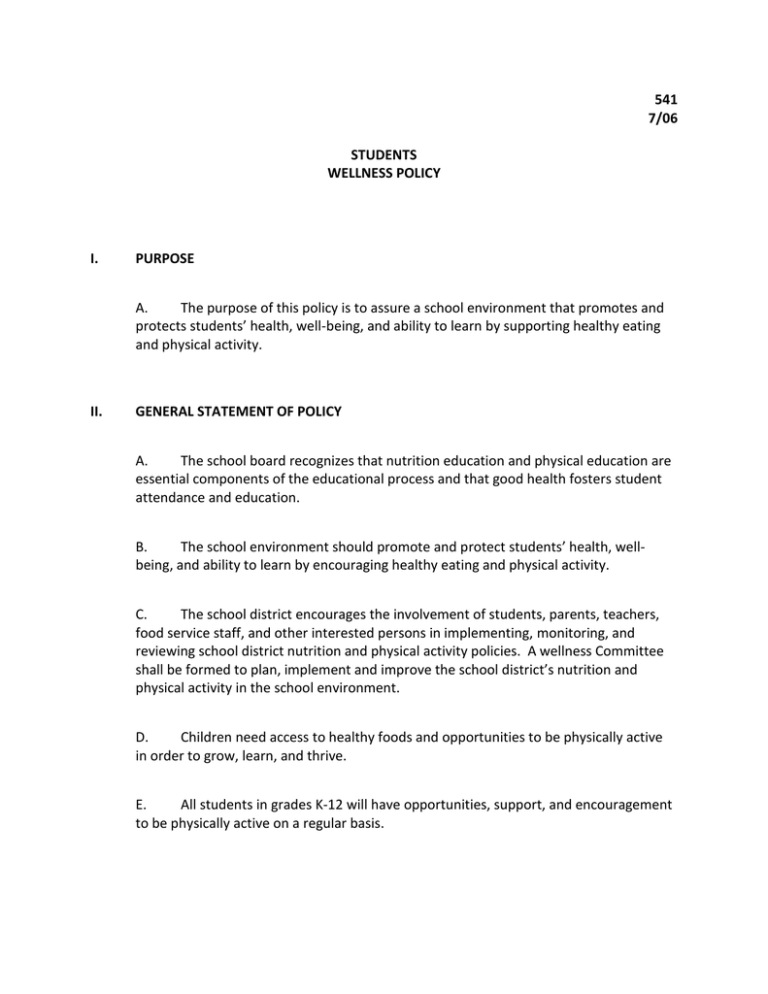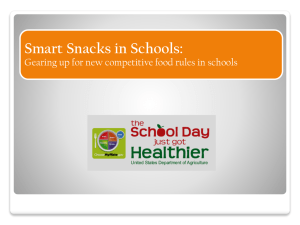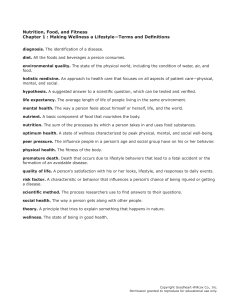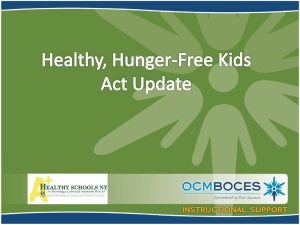MCW draftpolicy revision
advertisement

541 7/06 STUDENTS WELLNESS POLICY I. PURPOSE A. The purpose of this policy is to assure a school environment that promotes and protects students’ health, well-being, and ability to learn by supporting healthy eating and physical activity. II. GENERAL STATEMENT OF POLICY A. The school board recognizes that nutrition education and physical education are essential components of the educational process and that good health fosters student attendance and education. B. The school environment should promote and protect students’ health, wellbeing, and ability to learn by encouraging healthy eating and physical activity. C. The school district encourages the involvement of students, parents, teachers, food service staff, and other interested persons in implementing, monitoring, and reviewing school district nutrition and physical activity policies. A wellness Committee shall be formed to plan, implement and improve the school district’s nutrition and physical activity in the school environment. D. Children need access to healthy foods and opportunities to be physically active in order to grow, learn, and thrive. E. All students in grades K-12 will have opportunities, support, and encouragement to be physically active on a regular basis. F. Qualified food service personnel will provide students with access to a variety of affordable, nutritious, and appealing foods that meet the health and nutrition needs of students; try to accommodate the religious, ethnic, and cultural diversity of the student body in meal planning; and will provide clean, safe, and pleasant settings and adequate time for students to eat. III. GUIDELINES A. Foods and Beverages Served/Sold During the School Day 1. All foods and beverages made available on campus (including concessions, vending, beverage contracts and a la carte cafeteria items) will be consistent with the current USDA Dietary Guidelines for Americans and will promote students’ consumption of fresh fruits and vegetables, low fat and skim dairy products, whole grain products and portion controlled products. In addition, the offering of highly processed, high fat, high calorie, high sodium and high sugar foods will be discouraged. B. School Food Service Program/Personnel 1. The school district will provide healthy and safe school meal programs that strictly comply with all federal, state, and local statutes and regulations. 2. The school district will make every effort to eliminate any social stigma attached to, and prevent the overt identification of, students who are eligible for free and reduced-price school meals. Food and nutrition services will utilize electronic identification and payment systems; provide breakfast meals for K-8 grade students, regardless of income; promote the availability of school meals to all students 3. Food service personnel will take every measure to ensure that student access to foods and beverages meet or exceed all federal, state, and local laws and guidelines. 4. Food service personnel shall adhere to all federal, state, and local food safety and security guidelines. 5. The Director of Food and Nutrition Services shall be responsible for the school district’s food service program, whose duties shall include the creation of nutrition guidelines and procedures for the selection of foods and beverages made available on campus to ensure food and beverage choices are consistent with current USDA Dietary Guidelines for Americans 6. Food and Nutrition Services Programs will aim to be financially selfsupporting. However, the program is an essential educational support activity. Budget neutrality or profit generation will not take precedence over the nutritional needs of the students. Food and Nutrition Services will ensure that all students have affordable access to the varied and nutritious foods they need. 7. As part of the school district’s responsibility to operate a food service program, the school district will provide continuing professional development for all food and nutrition service personnel in schools. Staff development programs will include appropriate certification and/or training programs for the Director, Head Cooks and Food and Nutrition Services Staff, according to their levels of responsibility. 8. Food and beverages offered over the course of a school week will meet the requirement of the USDA National School Lunch and School Breakfast Program. 9. Foods and beverages available during the school day from food service will include a variety of healthy choices that are of excellent quality, appealing to students, and served at the proper temperatures. 10. Foods and beverages available during the school day from food service will minimize the use of trans and saturated fats, sodium and sugars as defined by the Dietary Guidelines for Americans. 11. School Breakfast: Students are encouraged to eat breakfast at home, as part of the School Breakfast program (K-8) or through the Quick Breakfast options available at the High School. The Quick Breakfast program at the high school will be open from 7:30 am – 8:15 am M-F. The a la carte line will not be open until lunch. 12. Food and beverage items offered as part of school breakfast or on the Quick Breakfast menu will meet the requirements of the USDA School Breakfast guidelines that include: a) Offering a fruit or 100% fruit juice b) Offering skim or 1% milk c) Offering whole grain bread or cereal d) Offering a meat or meat alternative that provides less than 35% of calories from total fat e) Total calories offered from breakfast will not exceed 500 for K-5; 550 for 6-8; and 600 for 9-12 13. Foods and beverages offered as part of the USDA’s National School Lunch Program (NSLP) will meet all regulations. The Food Service Director will be responsible for assuring that all USDA regulations are fully met. 14. Food and beverages will be offered in modest portion sizes ageappropriate for elementary, middle and high school students, respectively. C. Foods and beverages sold by the school outside of the School Breakfast Program and National School Lunch Program 1. Snack lines, vending and student stores will offer only healthy foods and beverages as defined below: a) Beverages: Water, skim or 1% milk, 100% fruit or vegetable juice, b) Foods: Fruits (fresh, canned or dried); vegetables (for example raw vegetables with low fat dip); nuts (limited to ¼ cup serving); low fat yogurt; low fat cheese sticks; whole wheat crackers or bread, c) Packaged snacks: Packaged snacks (such as granola bars, cereal bars, animal crackers) should contain no more than 200 kcals per package and less that 35% of calories from total fat, d) Once per week, school-prepared cookies will be available on the a la carte line at the High School, and e) 2. The a la carte line will only be open during lunch periods. Foods and beverages available throughout the school day a) Grades 7-8: Food and beverages in the classroom and hallways: Students will not be permitted to eat foods or drink beverages (other than water) in classrooms or in the hallway. b) Grades 9-12: Food and beverages in the classroom and hallways: Students are not permitted to eat snacks during the school day that are not purchased from the a la carte stand or school vending machines. The stand will be open from 7:30- 8:15 and 11:30-12:45. Students are not permitted to eat foods or drink beverages (other than water) in the classrooms. c) Food brought in for noon lunch must be consumed in the school cafeteria. d) Students in K-12 are not permitted to store foods or beverages in their locker for more than one day. 3. Classroom snacks, birthdays and celebrations a) School Breakfast Program: Students who are obviously hungry will be directed to the school breakfast program before they enter the classroom. b) Snacks: Snacks consumed during the school day (including breakfast and/or enrichment programs) will make a positive contribution to children’s diets and health; will emphasize serving whole grains, fruits, vegetables and dairy. The primary snack items are listed on the MCW snack list described under milk break. c) Milk Break: Milk break will consist of skim or 1% milk. Students may bring in healthy foods from home for milk break but it must be a food that is on the MCW Healthy Foods list. The MCW list of healthy foods include: popcorn, graham crackers, pretzels, animal crackers, teddy grahams and any fresh fruit or vegetable. Food items will not be stored in student’s locker for more than one school day. Teachers are encouraged to schedule milk breaks in the afternoon. d) Birthdays and classroom parties: Birthdays and classroom parties will be celebrated without food. Teachers are encouraged to use other forms of recognition for the student: examples include: allowing the student be 1st in line, hosting an extra recess or allowing student choose activity. e) Holiday parties: The classroom teacher decides if food will be a part of holiday parties. Teachers are encouraged to find other ways to celebrate holidays that do not include food. For example, for Valentine’s Day: Jump rope for heart or children may send valentines without candy, for winter break allow students in Junior High and 5 th/6th grade to watch a movie and have popcorn, and for Halloween choose class activities and games instead of candy and baked treats. f) Fundraising: To support children’s health and school nutritioneducation efforts, schools will encourage fundraising that promotes the sale of non-food and nutritious food items; being mindful of food safety. Schools will encourage fundraising activities that promote physical activity. g) School-sponsored Events: (such as, but not limited to, athletic events dances, or performances). Research shows that students will buy and consume healthy foods and beverages when the options are tasty, accessible and affordable. h) Concessions: Foods offered in Concessions during out of school events: Every effort should be made to offer healthy choices at schoolsponsored extramural events. Water should be available as beverage at all extramural functions; lower calorie and fat entrees (fewer than 600 calories per serving and less than 35% calories from total fat), fruits and whole grain products should be available. i) Rewards: Rewards and incentives will be used that do not undermine the health of students and/or reinforce unhealthful eating habits. Non-food rewards and incentives will be used unless food is used in teaching demonstrations. D. Other food/beverage related policies: 1. The school district will provide students access to hand washing or hand sanitizing before they eat meals or snacks. 2. The school district will make every effort to provide students with sufficient time to eat after sitting down for school meals and will schedule meal periods at appropriate times during the school day. 3. Should schedule meal periods at appropriate times i.e. lunch should be scheduled between 10:50 am and 1 pm. 4. Will consider scheduling lunch periods to follow recess periods (in elementary schools) to increase student nutrient intake and reduce food waste. 5. Dining areas are attractive and have enough space for seating all students. 6. The school district will not allow tutoring, club, or organizational meetings or activities during mealtimes, unless students may eat during such activities. 7. School site should discourage students from sharing their foods or beverages with one another during meals or snack times, given concerns about allergies and other restrictions on some children’s diets. 8. Schools will utilize methods to encourage participation in the school breakfast programs. Examples include arranging bus schedules or drop off sites when available and notifying parents about the availability of the School Breakfast Program. 9. When planning field trips which will occur during the scheduled lunch periods, the classroom teacher will, to the extent possible, collaborate with Food and Nutrition Services to provide students with the option of receiving a meal from School: being mindful of the number of students on free/reduced priced meals who may not be able to provide a lunch from home. 10. Advertising messages are consistent with and reinforce the objectives of the education and nutrition environment goals of the school. Advertising of foods or beverages in the areas accessible to the students during meal times must be consistent with standards established for the school environment. IV. NUTRITION EDUCATION AND PROMOTION A. The school district will encourage and support healthy eating practices by students and engage in nutrition promotion that is: 1. Offered as part of a sequential, comprehensive program designed to provide students with the knowledge and skills necessary to promote and protect their health; 2. Part of health education classes as well as classroom instruction in subjects such as math, science, language arts, social sciences, and elective subjects, where appropriate; and 3. Enjoyable, developmentally appropriate, culturally relevant, and includes participatory activities, such as contests, promotions, taste testing, and field trips. a) The staff responsible for nutrition education will be adequately prepared and participate regularly in professional development activities to effectively deliver an accurate nutrition education program. Preparation and professional development activities will provide basic knowledge of nutrition, combined with skill practice in program-specific, evidence based activities and instructional techniques and strategies designed to promote healthy eating habits. b) The school district will encourage all students to make age appropriate, healthy selections of foods and beverages, including those sold individually outside the reimbursable school meal programs, such as through a la carte [snack] lines, vending machines, fundraising events, concession stands, and student stores. c) The Director of Food and Nutrition Services or a Registered Dietitian (R.D.) will provide nutrition education to the classroom and will be available to review nutrition education information, upon request. d) The school cafeteria will serve as a “learning Laboratory” to allow students to apply nutrition skills taught in the classroom. The promotion of healthy foods, including fruits, vegetables, whole grains and low fat dairy products will be encouraged. Posting of the nutritional content will be available for students to review. e) The school district will provide information to families that encourage them to teach their children about health, nutrition and the importance of daily physical activity through the school newsletter. f) Staff wellness: MCW Schools highly values the health and wellbeing of every staff member and will plan and implement activities and policies that support personal efforts by staff to maintain a healthy lifestyle. The school staff should act as role models for good nutrition and physical activity behaviors. The district will establish and maintain a Staff Wellness Committee. The committee will develop, promote and oversee a multifaceted plan to promote staff health and wellness. V. Physical Activity A. Students need opportunities for physical activity and to fully embrace regular physical activity as a personal behavior. Toward that end, health education will reinforce the knowledge and self-management skills needed to maintain a healthy lifestyle and reduce sedentary activities such as watching television. 1. Physical Education (P.E.) K-10: a) All students in grades K-10 including students with disabilities, special health-care needs and in alternative educational settings, will receive regular physical education (or its equivalent of 125 minutes/week for elementary school students and 45 minutes/week for middle and high school students) for the entire school year. b) All physical education will be taught by a certified physical education teacher. c) The physical education curriculum should be coordinated with the health education curriculum. d) Physical education course will be held in an environment where students learn, practice and are assessed on developmentally appropriate motor skills, social skills and knowledge. e) Student involvement in other activities involving physical activity (i.e. interscholastic or intramural sports) will not be substituted for meeting the physical education requirement. f) Students will spend at least 50 percent of physical education class time participating in moderate to vigorous physical activity. 2. Integrating Physical Activity into the Classroom Setting: For students to receive the nationally recommended amount of daily physical activity (i.e. at least 60 minutes per day) and for students to fully embrace regular physical activity as a personal behavior, students need opportunities for physical activity beyond PE (physical education) class. Towards that end: a) Classroom health education will reinforce the knowledge and selfmanagement skills needed to maintain a healthy life style and reduce sedentary activities such as watching TV. b) Opportunities for physical activity will be incorporated into other subject lessons where appropriate. c) Classroom teachers will provide short physical activity breaks between lessons or classes, as appropriate. d) Daily Recess. All elementary school students will have at least 20 minutes a day of supervised recess, preferable outdoors, during which schools should encourage moderate to vigorous physical activity verbally and through the provision of space and equipment. Schools will discourage extended periods (i.e. periods or two or more hours) of inactivity. e) Physical Activity opportunities before and after school. All elementary, middle and high schools will offer extracurricular physical activity programs and interscholastic sports program. Schools will offer a range of activities that meet the needs interests and abilities of all students, including boys, girls, students with disabilities, and students with special health-care needs. f) Use of School facilities outside of school hours. School spaces and facilities will be available to students, staff and community members before, during and after the school day, on weekends, and during school vacations for physical activity. B. Communication with parents 1. The school district recognizes that parents and guardians have a primary and fundamental role in promoting and protecting their children’s health and well-being. 2. The school district will support parents’ efforts to provide a healthy diet and daily physical activity for their children. 3. The school district encourages parents to pack healthy lunches and snacks and refrain from including beverages and foods without nutritional value. 4. The school district will provide information about physical education and other school-based physical activity opportunities and will support parents’ efforts to provide their children with opportunities to be physically active outside of school. VI. IMPLEMENTATION AND MONITORING A. The School Health Index will be used to assess the nutrition and physical activity needs of students. Assessments will be repeated every three years to help review policy compliance, assess progress and determining areas in need of improvement. B. To satisfy the requirements of the Child Nutrition and WIC Reauthorization Act of 2004, the Wellness Committee will monitor and evaluate the school district’s implementation of the Wellness Policy. Once the policy is approved, the Wellness Committee will meet at least once a year to review and update the policy. C. Staff responsible for the areas outlined within this policy, at the school or district level, will ensure compliance and will report to the Wellness Committee, as appropriate. D. The superintendent or designee will ensure compliance with the wellness policy and will provide an annual report of the school district’s compliance with the policy to the school board.





